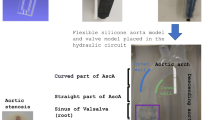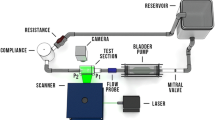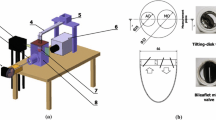Abstract
The performance of a transcatheter aortic valve (TAV) can be evaluated by analyzing the flow field downstream of the valve. However, three dimensional flow and pressure fields, and particle residence time, a quantity closely related to thrombosis risk, are challenging to obtain. This experimental study aims to provide a comprehensive 3D measurement of the flow field downstream of an Edwards SAPIEN 3 using time-resolved 3D particle tracking velocimetry (3D PTV) with Shake-the-Box (STB) algorithm. The valve was deployed in an idealized aorta model and tested in a left heart simulator under physiological conditions. Detailed 3D vortical structures, pressure distributions, and particle residence time were obtained by analyzing the 3D particle tracks. Results have shown large-scale retrograde flow entering the sinuses of the TAV at systole, reducing flow stasis there. However, the 3D particle tracks reveal that the retrograde flow has a high residence time and might have already experienced high shear stress near the main jet. Thus by only focusing on the flow in the sinus region is not sufficient to evaluate the leaflet thrombosis risk, and the flow downstream of the valve should be taken into consideration. The unique perspectives offered by 3D PTV are important when evaluating the performance of the TAVs.






Similar content being viewed by others
References
Agarwal, K., O. Ram, J. Wang, Y. Lu, and J. Katz. Reconstructing velocity and pressure from noisy sparse particle tracks using constrained cost minimization. Exp Fluids. 62:2021, 2021.
Brindise, M. C., M. M. Busse, and P. P. Vlachos. Density and viscosity matched newtonian and non-newtonian blood-analog solutions with PDMS Refractive Index. Exp Fluids. 59:2018, 2018.
Corso, P., U. Gulan, N. Cohrs, W. J. Stark, F. Duru, and M. Holzner. Comprehensive in vitro study of the flow past two transcatheter aortic valves: comparison with a severe stenotic case. Ann Biomed Eng. 47:2241–2257, 2019.
de Kat, R., and B. W. van Oudheusden. Instantaneous planar pressure determination from PIV in turbulent flow. Exp Fluids. 52:1089–1106, 2011.
De Paulis, R., G. M. De Matteis, P. Nardi, R. Scaffa, C. Bassano, and L. Chiariello. Analysis of valve motion after the reimplantation type of valve-sparing procedure (David I) with a new aortic root conduit. Ann Thorac Surg. 74:53–57, 2002.
Duncan, D. D., C. B. Bargeron, S. E. Borchardt, O. J. Deters, S. A. Gearhart, F. F. Mark, and M. H. Friedman. The effect of compliance on wall shear in casts of a human aortic bifurcation. J Biomech Eng. 112:183–188, 1990.
Farag, E. S., J. Vendrik, P. van Ooij, Q. L. Poortvliet, F. van Kesteren, L. W. Wollersheim, A. Kaya, A. H. G. Driessen, J. J. Piek, K. T. Koch, J. Baan, R. N. Planken, J. Kluin, A. J. Nederveen, and B. de Mol. Transcatheter aortic valve replacement alters ascending aortic blood flow and wall shear stress patterns: a 4D flow MRI comparison with age-matched, elderly controls. Eur Radiol. 29:1444–1451, 2019.
Garcia, D., J. G. Dumesnil, L.-G. Durand, L. Kadem, and P. Pibarot. Discrepancies between catheter and Doppler estimates of valve effective orifice area can be predicted from the pressure recovery phenomenon. J Am Coll Cardiol. 41:435–442, 2003.
Geoghegan, P. H., N. A. Buchmann, C. J. T. Spence, S. Moore, and M. Jermy. Fabrication of rigid and flexible refractive-index-matched flow phantoms for flow visualisation and optical flow measurements. Exp Fluids. 52:1331–1347, 2012.
Ghidaoui, M. S., M. Zhao, D. A. McInnis, and D. H. Axworthy. A review of water hammer theory and practice. Appl Mech Rev. 58:49–76, 2005.
Gilmanov, A., T. B. Le, and F. Sotiropoulos. A numerical approach for simulating fluid structure interaction of flexible thin shells undergoing arbitrarily large deformations in complex domains. J Comput Phys. 300:814–843, 2015.
Graf, T., H. Fischer, H. Reul, and G. Rau. Cavitation potential of mechanical heart valve prostheses. Int J Artif Org. 14:169–174, 2018.
Haller Lagrangian, G., and Coherent Structures. Ann Rev Fluid Mech. 47:137–162, 2015.
Hasler, D., A. Landolt, and D. Obrist. Tomographic PIV behind a prosthetic heart valve. Exp Fluids. 57:2016, 2016.
Hasler, D., and D. Obrist. Three-dimensional flow structures past a bio-prosthetic valve in an in-vitro model of the aortic root. PLoS ONE.13:e0194384, 2018.
Hatoum, H., R. T. Hahn, S. Lilly, and L. P. Dasi. Differences in pressure recovery between balloon expandable and self-expandable transcatheter aortic valves. Ann Biomed Eng. 48:860–867, 2020.
Hatoum, H., B. L. Moore, and L. P. Dasi. On the significance of systolic flow waveform on aortic valve energy loss. Ann Biomed Eng. 46:2102–2111, 2018.
Hatoum, H., A. Yousefi, S. Lilly, P. Maureira, J. Crestanello, and L. P. Dasi. An in vitro evaluation of turbulence after transcatheter aortic valve implantation. J Thorac Cardiovasc Surg. 156:1837–1848, 2018.
Heinrich, R. S., A. A. Fontaine, R. Y. Grimes, A. Sidhaye, S. Yang, K. E. Moore, R. A. Levine, and A. P. Yoganathan. Experimental analysis of fluid mechanical energy losses in aortic valve stenosis: importance of pressure recovery. Ann Biomed Eng. 24:685–694, 1996.
Hunt J. C., A. A. Wray and P. Moin. Eddies, streams, and convergence zones in turbulent flows. In: Studying Turbulence Using Numerical Simulation Databases, 2. Proceedings of the 1988 Summer Program NASA Technical Reports, 1988, pp. 193–208.
Jeronimo, M. D., and D. E. Rival. Particle Residence Time in pulsatile post-stenotic flow. Phys Fluids. 32:2020, 2020.
Jeronimo, M. D., K. Zhang, and D. E. Rival. Direct Lagrangian measurements of particle residence time. Exp Fluids. 60:2019, 2019.
Jin, S., J. Oshinski, and D. P. Giddens. Effects of wall motion and compliance on flow patterns in the ascending aorta. J Biomech Eng. 125:347–354, 2003.
Khojasteh, A. R., Y. Yang, D. Heitz, and S. Laizet. Lagrangian coherent track initialization. Phys Fluids. 33:2021, 2021.
Lancellotti, P., P. Pibarot, J. Chambers, T. Edvardsen, V. Delgado, R. Dulgheru, M. Pepi, B. Cosyns, M. R. Dweck, M. Garbi, J. Magne, K. Nieman, R. Rosenhek, A. Bernard, J. Lowenstein, M. L. Vieira, A. Rabischoffsky, R. H. Vyhmeister, X. Zhou, Y. Zhang, J. L. Zamorano, and G. Habib. Recommendations for the imaging assessment of prosthetic heart valves: a report from the European Association of Cardiovascular Imaging endorsed by the Chinese Society of Echocardiography, the Inter-American Society of Echocardiography, and the Brazilian Department of Cardiovascular Imaging. Eur Heart J Cardiovasc Imaging. 17:589–590, 2016.
Laskey, W. K., and W. G. Kussmaul. Pressure recovery in aortic valve stenosis. Circulation. 89:116–121, 1994.
Liu, X., and J. Katz. Instantaneous pressure and material acceleration measurements using a four-exposure PIV system. Exp Fluids. 41:227–240, 2006.
Mao, W., K. Li, and W. Sun. Fluid-structure interaction study of transcatheter aortic valve dynamics using smoothed particle hydrodynamics. Cardiovasc Eng Technol. 7:374–388, 2016.
Midha, P. A., V. Raghav, R. Sharma, J. F. Condado, I. U. Okafor, T. Rami, G. Kumar, V. H. Thourani, H. Jilaihawi, V. Babaliaros, R. R. Makkar, and A. P. Yoganathan. The fluid mechanics of transcatheter heart valve leaflet thrombosis in the neosinus. Circulation. 136:1598–1609, 2017.
Mikell, F. L., R. W. Asinger, K. J. Elsperger, W. R. Anderson, and M. Hodges. Regional stasis of blood in the dysfunctional left ventricle: echocardiographic detection and differentiation from early thrombosis. Circulation. 66:755–763, 1982.
Polanczyk, A., M. Klinger, J. Nanobachvili, I. Huk, and C. Neumayer. Artificial circulatory model for analysis of human and artificial vessels. Appl Sci. 8:2018, 2018.
Reul, H., A. Vahlbruch, M. Giersiepen, T. Schmitz-Rode, V. Hirtz, and S. Effert. The geometry of the aortic root in health, at valve disease and after valve replacement. J Biomech. 23:181–191, 1990.
Robicsek, F., and M. J. Thubrikar. Role of sinus wall compliance in aortic leaflet function. Am J Cardiol. 84:944–946, 1999.
Samaee, M., H. Hatoum, M. Biersmith, B. Yeats, S. C. Gooden, V. H. Thourani, R. T. Hahn, S. Lilly, A. Yoganathan, and L. P. Dasi. Gradient and pressure recovery of a self-expandable transcatheter aortic valve depends on ascending aorta size: In vitro study. JTCVS Open. 9:28–38, 2022.
Sammour, Y., K. Banerjee, A. Kumar, H. Lak, S. Chawla, C. Incognito, J. Patel, M. Kaur, O. Abdelfattah, L. G. Svensson, E. M. Tuzcu, G. W. Reed, R. Puri, J. Yun, A. Krishnaswamy, and S. Kapadia. Systematic approach to high implantation of SAPIEN-3 valve achieves a lower rate of conduction abnormalities including pacemaker implantation. Circ Cardiovasc Interv. 14:e009407, 2021.
Schanz, D., S. Gesemann, and A. Schröder. Shake-The-Box: Lagrangian particle tracking at high particle image densities. Exp Fluids. 57:2016, 2016.
Schanz, D., S. Gesemann, A. Schröder, B. Wieneke, and M. Novara. Non-uniform optical transfer functions in particle imaging: calibration and application to tomographic reconstruction. Measur Sci Technol. 24:2013, 2013.
Schneiders, J. F. G., R. P. Dwight, and F. Scarano. Time-supersampling of 3D-PIV measurements with vortex-in-cell simulation. Exp Fluids. 55:2014, 2014.
Schneiders, J. F. G., and F. Scarano. Dense velocity reconstruction from tomographic PTV with material derivatives. Exp Fluids. 57:2016, 2016.
Sheng, J., E. Malkiel, and J. Katz. Using digital holographic microscopy for simultaneous measurements of 3D near wall velocity and wall shear stress in a turbulent boundary layer. Exp Fluids. 45:1023–1035, 2008.
Sirois, E., W. Mao, K. Li, J. Calderan, and W. Sun. Simulated transcatheter aortic valve flow: implications of elliptical deployment and under-expansion at the aortic annulus. Artif Organs. 42:E141–E152, 2018.
Sotiropoulos, F., T. B. Le, and A. Gilmanov. Fluid mechanics of heart valves and their replacements. Ann Rev Fluid Mech. 48:259–283, 2016.
Spevack, D. M., K. Almuti, R. Ostfeld, R. Bello, and G. M. Gordon. Routine adjustment of Doppler echocardiographically derived aortic valve area using a previously derived equation to account for the effect of pressure recovery. J Am Soc Echocardiogr. 21:34–37, 2008.
Timms, D., M. Hayne, K. McNeil, and A. Galbraith. A complete mock circulation loop for the evaluation of left, right, and biventricular assist devices. Artif Org. 29:564–572, 2005.
Trusty, P. M., S. S. Bhat, V. Sadri, M. T. Salim, E. Funnell, N. Kamioka, R. Sharma, R. Makkar, V. Babaliaros, and A. P. Yoganathan. The role of flow stasis in transcatheter aortic valve leaflet thrombosis. J Thorac Cardiovasc Surg. 164:e105–e117, 2022.
van Gent, P. L., D. Michaelis, B. W. van Oudheusden, P. É. Weiss, R. de Kat, A. Laskari, Y. J. Jeon, L. David, D. Schanz, F. Huhn, S. Gesemann, M. Novara, C. McPhaden, N. J. Neeteson, D. E. Rival, J. F. G. Schneiders, and F. F. J. Schrijer. Comparative assessment of pressure field reconstructions from particle image velocimetry measurements and Lagrangian particle tracking. Exp Fluids. 58:2017, 2017.
van Oudheusden, B. W. PIV-based pressure measurement. Measur Sci Technol. 24:2013, 2013.
Wang, J., C. Zhang, and J. Katz. GPU-based, parallel-line, omni-directional integration of measured pressure gradient field to obtain the 3D pressure distribution. Exp Fluids. 60:2019, 2019.
Westerweel, J., and F. Scarano. Universal outlier detection for PIV data. Exp Fluids. 39:1096–1100, 2005.
Wieneke, B. Volume self-calibration for 3D particle image velocimetry. Exp Fluids. 45:549–556, 2008.
Wunsch, C. The Ocean Circulation Inverse Problem. Cambridge: Cambridge University Press, 2010.
Wylie, B., V. Streeter, and L. Suo. Fluid Transients in Systems. Englewood Cliffs, NJ: Prentice Hall, 1993.
Yazdi, S. G., P. H. Geoghegan, P. D. Docherty, M. Jermy, and A. Khanafer. A review of arterial phantom fabrication methods for flow measurement using PIV techniques. Ann Biomed Eng. 46:1697–1721, 2018.
Zhang, C., J. Wang, W. Blake, and J. Katz. Deformation of a compliant wall in a turbulent channel flow. J Fluid Mech. 823:345–390, 2017.
Author information
Authors and Affiliations
Corresponding author
Ethics declarations
Conflict of interest
Dr. Dasi reports having patent applications filed on novel polymeric valves, vortex generators and superhydrophobic/omniphobic surfaces. Dr. Dasi and Dr. Chen have patents pending on predictive computational modeling in TAVR. Dr. Dasi is a co-founder and stockholder of DasiSimulations LLC and YoungHeartValve Inc. No other conflicts were reported.
Additional information
Associate Editor Jane Grande-Allen oversaw the review of this article.
Publisher's Note
Springer Nature remains neutral with regard to jurisdictional claims in published maps and institutional affiliations.
Supplementary Information
Below is the link to the electronic supplementary material.
Supplementary file2 (M4V 43533 KB).
Supplementary file3 (M4V 23415 KB).
Supplementary file4 (M4V 25477 KB).
Supplementary file5 (M4V 54057 KB).
Rights and permissions
Springer Nature or its licensor (e.g. a society or other partner) holds exclusive rights to this article under a publishing agreement with the author(s) or other rightsholder(s); author self-archiving of the accepted manuscript version of this article is solely governed by the terms of such publishing agreement and applicable law.
About this article
Cite this article
Chen, H., Dasi, L.P. An In-Vitro Study of the Flow Past a Transcatheter Aortic Valve Using Time-Resolved 3D Particle Tracking. Ann Biomed Eng 51, 1449–1460 (2023). https://doi.org/10.1007/s10439-023-03147-8
Received:
Accepted:
Published:
Issue Date:
DOI: https://doi.org/10.1007/s10439-023-03147-8




